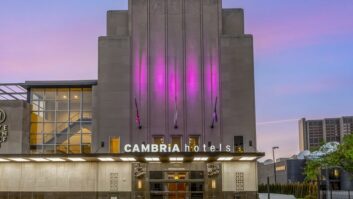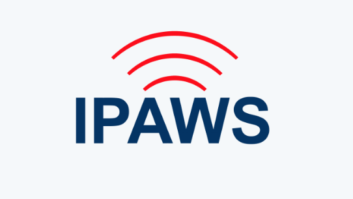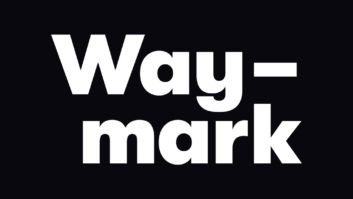IBOC Update – Apr 6, 2006
Apr 6, 2005 10:26 AM, By Mark Krieger, CBT
Index:
- FCC: IBOC Experimental Authority Requests Require Drug Certification
- CPB Extends Digital Conversion Application Deadline
- Clarification on Kenwood Radio Deal for NPR
- Streaming Audio Service over Cellular Debuts in United States
- Harris to Showcase DRM Product at NAB2005
- Bonneville Picks Up Conversion Pace With BE
- Ibiquity To Host HD Radio Press Conference at NAB2005
- HD Radio Article Homes In on IBOC Price Barrier
- WFAE Conducts On-air Demonstration of Two Supplemental Channels
- New DAB Receivers To Offer Slide-Shows
- DRE Demos FM Digital Subcarrier System for Religious Broadcasters
- An Introduction to the New Language Surrounding HD Radio
- IBOC By State: New Mexico
To receive these articles twice a month in your e-mail, subscribe to the IBOC Update – Insight on HD Radio e-newsletter. Click here to subscribe.NewsFCC: IBOC Experimental Authority Requests Require Drug Certification
Broadcasters asking for permission to transmit multiple program streams must “just say no” before the FCC will say yes, according to sources at National Public Radio (NPR). In a memo dated March 24, NPR advised all of its member stations that an Anti-Drug Abuse Certification statement must be included with all Tomorrow Radio Experimental Authorization requests, contradicting advice previously offered by the FCC’s Media Bureau staff.The experimental authorization requests were stipulated by the FCC as a requirement for any station wishing to add Secondary Program Services (SPS) to its IBOC digital transmissions. Public Notice DA 05-609, issued by the FCC on March 8, allowed that simply simply tendering a letter asking for experimental authorization on an informal basis was sufficient, but further inquiries by NPR legal staff indicate that the Commission is requesting that an Anti-Drug Abuse Certification statement, required in many other formal filings, accompany the request for experimental authorization.To address the issue, NPR has made a revised application template available for use by its member stations seeking SPS experimental authority.Furthermore, NPR advises that any station that has already submitted a request for experimental authorization without an Anti-Drug Abuse Certification declaration must submit a revised request that includes the declaration, and that Media Bureau staff will attempt to expedite the revised requests.CPB Extends Digital Conversion Application Deadline
The Corporation for Public Broadcasting (CPB) has extended the deadline for eligible stations to apply for the current round of digital radio conversion funding from April 29 to May 27.Application materials and guidelines can be found at www.cpb.org/grants/digitalradioconversion. All CPB qualified stations are eligible and are encouraged to apply.BusinessClarification on Kenwood Radio Deal for NPR
In the March 23 issue of IBOC Update, we reported that Kenwood was offering HD Radio tuner units with Supplemental Program Service (SPS) capability to NPR member stations. The information we cited came from an NPR memo. The memo made it appear that up to 12 radios were being offered to each NPR affiliate, when in reality only 12 radios in total were offered to all affiliates. Mike Bergman of Kenwood notified us of the clarification.The tuners were offered to NPR affiliates because of the long-standing relationship between NPR and Kenwood. Stations could purchase the modified tuners at the prototype manufacturing price, which is substantially higher than a consumer model process because of the limited run.The NPR memo also stated that Kenwood had offered to upgrade the KTC-HR100 HD Radio tuner units to receive SPS. Bergman noted that this was not offered.Streaming Audio Service over Cellular Debuts in United States
Radio station owners already queasy over the potential impact of new technologies such as the Ipod and satellite radio may want to reach for the Maalox once more, as streaming audio broadcast services have just become available to Sprint PCS Vision phone subscribers, via Palo-Alto based technology firm MSpot.According to an article appearing in this week’s C/NET News, the MSpot Radio service is initially offering Sprint subscribers 13 channels of live and on-demand programming, including selected content from National Public Radio. The $5.95 monthly subscription service is delivered via IP media streams, and is said to be compatible with any Web-ready handset.While MSpot CEO Daren Tsui may be making terrestrial broadcasters nervous, he says that his real target is satellite radio, which has difficulty penetrating large structures. Even though the service is currently offering only eight music formats, Tsui claims that new channels can be added quickly, and that there is no practicable limit on what can be offered, other than the laws of economics dictated by demand.Although Sprint is now the only carrier offering the service, MSpot claims it will be adding more before the close of 2005. Many cellular service providers are said to be attracted to the service as an inducement for consumers to upgrade to Hi-fi handsets and no-limit service plans. Streaming audio/video for cellular subscribers is now being offered in Japan and Korea, and Virgin radio is developing European program distribution for 3GSM subscribers there.Harris to Showcase DRM Product at NAB2005
Harris Corporation Broadcast Communications Division has announced that it will demonstrate and end-to-end digital air chain for use with the Digital Radio Mondiale (DRM) format at NAB2005 later this month in Las Vegas. Following winter demonstrations in Romania and Mexico, NAB2005 will be Harris’ first-ever United States demonstration of DRM.Visitors to the Harris booth will witness an operational DAX1 AM transmitter with a DRM modulator and content server designed for international regions that support the format. The DRM content server encodes audio and combines it with digital program information into one bitstream that is sent to the transmitter, where the DRM signal modulation actually takes place.DAX series transmitters use Digital Adaptive Modulation, which Harris describes as a modulation technology that employs a digitally generated AM waveform and DSP-based adaptive correction that samples the modulated output and dynamically corrects for non-linearity.The advantages of DRM were most recently illustrated in Romania during a live broadcast by engineers from Harris Broadcast Communications Division and S.N. Radiocomunicatii S.A. The broadcast, part of the Digital Radio Mondiale and Broadcast Modernization Symposium held in Bucharest, demonstrated on-site conversion of a conventional solid-state analog radio transmission system, culminating with a live DRM transmission.A similar test was recently held in Mexico as part of the semiannual High Frequency Coordination Conference meeting.Bonneville Picks Up Conversion Pace With BE
Following the lead of several other radio ownership groups, Bonneville International recently placed orders to equip seven more of its stations for IBOC digital operation in the St. Louis, DC and Phoenix markets. All of the stations are slated for conversion sometime before May, with Broadcast Electronics being tapped as the vendor.Included in the lineup are St. Louis stations WIL (FM) and WVRV (FM), along with WGMS (FM), WWZZ (FM), and WTOP (AM/FM) in Washington DC and KKLT-FM Phoenix.Bonneville completed extensive separate antenna tests using BE equipment at the group’s San Francisco station, KDFC (FM), in 2003. Since then, KDFC (FM) and two other company stations in San Francisco, KZBR (FM) and KOIT (FM), converted to the HD Radio standard, followed by WTMX (FM) and WDRV (FM) in Chicago.Ibiquity To Host HD Radio Press Conference at NAB 2005
Ibiquity Digital will use NAB2005 as an opportunity to brief reporters on plans to support the HD Radio rollout announced by 21 radio ownership groups during the past six months. Entitled “Consumer Electronics Industry Demonstrates Support of HD Radio,” the press conference will take place at the NAB2005 convention on Tuesday, April 19 at 11:00 a.m. PST in Room N243 of the Las Vegas Convention Center.Among those attending will be Robert Struble, CEO, Ibiquity Digital; Stephen Shenefield of Boston Acoustics; Rob Lopez from Panasonic Electronics Group; Tim Caokley of Good Guys; Paul DiComo from Polk Audio; Richard Skeie, Radiosophy; and Tom Van Voy from Sanyo’s AV Division.Anyone interested in arranging interviews or wishing additional information can contact Vicki Stearn at [email protected], or Gil Chorbajian at [email protected].Eye on IBOCWFAE Conducts On-air Demonstration of Two Supplemental Channels
Quincy, IL – Apr 6, 2005 – NPR’s WFAE has conducted live tests of two supplemental audio channels over HD Radio using Broadcast Electronics’ new IDI 20 importer unit. NPR has conducted lab tests of multiple supplemental audio channels, but this is the first on-air demonstration of two supplemental channels.The test comes just one year after initial testing of Tomorrow Radio and follows close behind the FCC’s March 8 announcement clarifying experimental licensing of Secondary Program Services.HD Radio Article Homes In on IBOC Price Barrier
An article on HD Radio appearing in the Sunday, April 3 edition of The Chicago Tribune doesn’t mince words about the single biggest perceived barrier standing between consumers and IBOC digital receivers. And while Tribune AV writer Kevin Hunt has a lot of positive things to say about HD Radio, he also manages to compress one paragraph into just four syllables: “It isn’t cheap.”That statement may say a lot about what many broadcasters feel is a peculiar state of affairs now confronting the IBOC digital rollout; namely, that many consumers are embracing satellite radio–a subscription service currently subsidizing receiver costs to build numbers–while so far avoiding HD Radio because they perceive it to be overpriced at an average per-receiver cost of about $300.In fact, the article reiterates what a number of studies have already suggested: Consumers are more willing than ever to pay for content, but have come to expect low hardware prices. Even Ibiquity CEO Bob Strubble concedes the point, saying, “Eighty percent of radios in this country are sold below $200…that’s sort of the magic number.”So, while many broadcasters now appear to be ready to spend at least $100,000 per station to transmit a digital signal, the question remains whether consumers are willing to spend more than $100 dollars to receive it. That’s an irony not likely to be lost among stakeholders in an industry that’s been giving away programming for the last eighty-five years.ProductsNew DAB Receivers To Offer Slide-Shows
Sonarics Labs, which offers single, general-purpose DSP solutions for Digital Audio Broadcasting (DAB), has announced the development of a new version known as Clear Signal, purported to be the industry’s first DAB integrated software capable of displaying a photo album and DAB MOT slide shows on a color LCD.The company claims this new functionality will benefit radio listeners and broadcasters alike, as consumers will be able to choose between displaying their own stored JPG photos or visual images transmitted alongside audio programmingSonarics says the new Clear Signal DSP solution is currently available, and that two products based on the technology will be launched in mid-2005 by its customers.DRE Demos FM Digital Subcarrier System for Religious Broadcasters
Digital Radio Express (DRE) a Silicon Valley-based technology company recently demonstrated its FM Extra digital radio technology to radio broadcasters at the National Religious Broadcasters Expo (NRB). The company claims that the technology enables an FM station to simultaneously broadcast multiple digital programs at a total data rate of 96 kb/s, while using existing analog transmitter equipment and licenses.DRE is promoting its product as a way to “provide broadcasters with an extremely low cost method of expanding their audience by providing unique and specialized programming.”FMeXtra radio receivers are based on ST Microelectronics’ digital radio chip set, said to be using Digital Intermediate Frequency (DIF) architecture.Rikei of Japan will produce FM Extra radios. Katsuei Aoyagi, president of Rikei, said, ” The fact that DRE’s FM Extra digital subcarrier system is applicable worldwide is of particular importance since Rikei has extensive sales and marketing organization throughout Asia where there is a significant market for this technology.”HD Radio Terminology An Introduction to the New Language Surrounding HD RadioNRSC: National Radio Systems Committee, a technical standards setting body of the radio broadcasting industry, co-sponsored by the Consumer Electronics Association (CEA) and the National Association of Broadcasters (NAB).IBOC Across AmericaIBOC by State: New Mexico
Ibiquity has a list of stations that have licensed HD Radio technology and notes those that are on the air now. IBOC by State will look at various states and list the stations that are making the transition. Stations Format Market Owner On Air KANW-FM 89.1 NPR/Ethnic Albuquerque Board of Education, City of Albuquerque No KUNM-FM 89.9 NPR/Ethnic Albuquerque University of New Mexico No KGLP-FM 91.7 Public Gallup Gallup Public Radio No












